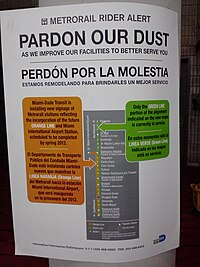As of 2010, those of (non-Hispanic white) European ancestry accounted for 57.9% of Florida's population. Out of the 57.9%, the largest groups were 12.0% German (2,212,391), 10.7% Irish (1,979,058), 8.8% English (1,629,832), 6.6% Italian (1,215,242), 2.8% Polish (511,229), and 2.7% French (504,641).[104][105] White Americans of all European backgrounds are present in all areas of the state. In 1970, non-Hispanic whites were nearly 80% of Florida's population.[113] Those of English and Irish ancestry are present in large numbers in all the urban/suburban areas across the state. Some native white Floridians, especially those who have descended from long-time Florida families, may refer to themselves as "Florida crackers"; others see the term as a derogatory one. Like whites in most of the other Southern states, they descend mainly from English and Scots-Irish settlers, as well as some other British American settlers.[114]
Cuban men playing dominoes in Miami's Little Havana. In 2010, Cubans made up 34.4% of Miami's population and 6.5% of Florida's.[115][116]
As of 2010, those of African ancestry accounted for 16.0% of Florida's population, which includes African Americans. Out of the 16.0%, 4.0% (741,879) were West Indian or Afro-Caribbean American.[104][105][116] During the early 1900s, black people made up nearly half of the state's population.[121] In response to segregation, disfranchisement and agricultural depression, many African Americans migrated from Florida to northern cities in the Great Migration, in waves from 1910 to 1940, and again starting in the later 1940s. They moved for jobs, better education for their children and the chance to vote and participate in society. By 1960 the proportion of African Americans in the state had declined to 18%.[122] Conversely large numbers of northern whites moved to the state.[citation needed] Today, large concentrations of black residents can be found in northern and central Florida. Aside from blacks descended from African slaves brought to the US south, there are also large numbers of blacks of West Indian, recent African, and Afro-Latino immigrant origins, especially in the Miami/South Florida area. In 2010, Florida had the highest percentage of West Indians in the United States, with 2.0% (378,926) from Haitian ancestry, and 1.3% (236,950) Jamaican.[123] All other (non-Hispanic) Caribbean nations were well below 0.1% of Florida residents.[123][124]
As of 2010, those of Asian ancestry accounted for 2.4% of Florida's population.[104][105]
Languages
20% of Floridians speak Spanish, the second most widely-spoken language.
See also: Demographics of Florida § Languages, and Miami accent
In 1988 English was affirmed as the state's official language in the Florida Constitution.
Spanish is also widely spoken, especially as immigration has continued
from Latin America. Twenty percent of the population speak Spanish as
their first language. Twenty-seven percent of Florida's population
reports speaking a mother language other than English, and more than 200 first languages other than English are spoken at home in the state.[125][126]The most common languages spoken in Florida as a first language in 2010 are:[125]
- 73% — English
- 20% — Spanish
- 2% — Haitian Creole
- Other languages comprise less than 1% spoken by the state's population
Religion
Miami Cathedral of Saint Mary. Roman Catholicism is the largest single religious denomination in the state.
- Christian 70%
- 24% Evangelical Protestant
- 21% Catholic
- 14% Mainline Protestant
- 8% Black Protestant
- 3% Other Christian
- 3% Jewish
- 3% Other non-Christian faiths
- 24% Unaffiliated
Florida is mostly Protestant, but Roman Catholicism is the single largest denomination in the state, due in significant part to the state's large Hispanic population. There is also a sizable Jewish community, located mainly in South Florida; this is the largest Jewish population in the South and the third-largest in the U.S. behind those of New York and California.[129]



No comments:
Post a Comment